During its heyday, the label issued some very interesting and successful popular music, along with a carload of schmaltz and yawners, at least on the album side of the house. The singles side had more doo-wops, rockabilly, and generally interesting offerings. Country star Kenny Rogers made his recording debut on Carlton. Successful acts included Jack Scott, Anita Bryant, Paul Evans, the Chantels, Gary Stites, and others. Carlton also issued a series of "Hear How To..." albums long before DIY became a well-known acronym.
The label started with a single by Tommy Fredericks & His Hi-Notes, "The Prince of Players"/"I'm Not Pretending" [Carlton 450]. A few singles later, Joe Carlton signed an unknown singer out of Texas named Kenny Rogers. His first single, "That Crazy Feeling" [Carlton 454], was attributed to Kenneth Rogers. The song sold some, but not enough to make the charts. In the late 1970s, Kenny Rogers was a household name, and was being interviewed by New York country jock Mike Fitzgerald on WHN about his "first record," which Rogers was referring to as "Just Dropped In" by the First Edition. Unbeknownst to Rogers, Fitzgerald cued up "That Crazy Feeling," and you could hear the shocked Rogers whisper on the air, "where did you get THIS??" A second Carlton single, "For You Alone"/"I've Got A Lot to Learn" [Carlton 468], sold poorly, and Rogers was dropped from the label.
Other artists releasing singles on Carlton during early 1958 included Al & Dick, Johnny Brantley's All Stars, rockabilly singer Dwight Pullen, Charles Margulis (who also had an album), the Double Daters, Fred Norman & the Abnormals, and Buddy Hawkins.
 About mid-1958, Carlton signed it's biggest star, Jack Scott. His given name was Giovanni Dominico
Scafone, born in Windsor, Ontario, just across the river from Detroit, where he grew up. He started
playing guitar and singing in the early 1950s, and by 1957, he was appearing with his own band around
the Detroit area. He was signed to ABC-Paramount and had a couple of 45s which didn't sell outside of
Detroit, and when he played the demos of what he thought would be his next single, "Leroy"/"My True
Love", ABC passed on it. A New York promoter heard the songs and brought them to Joe Carlton, who
signed Scott and his backing vocal group, the Chantones (Jack Grenier, Jim Nantais, Roy Lesperance,
and Larry Desgarlais). Carlton purchased the masters for $4,800 and the record became a two-sided hit
[Carlton 462], with "My True Love" reaching #3 and "Leroy" just missing the top 10 at #11. Carlton
immediately recorded an album's worth of material back in Detroit, this time in stereo.
About mid-1958, Carlton signed it's biggest star, Jack Scott. His given name was Giovanni Dominico
Scafone, born in Windsor, Ontario, just across the river from Detroit, where he grew up. He started
playing guitar and singing in the early 1950s, and by 1957, he was appearing with his own band around
the Detroit area. He was signed to ABC-Paramount and had a couple of 45s which didn't sell outside of
Detroit, and when he played the demos of what he thought would be his next single, "Leroy"/"My True
Love", ABC passed on it. A New York promoter heard the songs and brought them to Joe Carlton, who
signed Scott and his backing vocal group, the Chantones (Jack Grenier, Jim Nantais, Roy Lesperance,
and Larry Desgarlais). Carlton purchased the masters for $4,800 and the record became a two-sided hit
[Carlton 462], with "My True Love" reaching #3 and "Leroy" just missing the top 10 at #11. Carlton
immediately recorded an album's worth of material back in Detroit, this time in stereo.
 The next single, "With Your Love"/"Geraldine" [Carlton483] was a
blatant copy of the formula of the first record, with a slow ballad and a fast rocker, but the public was
lukewarm and "With Your Love" only reached #28. "Goodbye Baby" [Carlton 493] and its flip, "Save My
Soul," made the third straight double-sided charter, but this time the uniqueness of "Goodbye Baby"
caught on and it made #8. Another unique single was "The Way I Walk" [Carlton 514], which reached
#35 in 1959. Part of its charm was the third verse, which had the Chantones singing "Ooo-wee,
ooo-wee" while Jack threw in short comments like "That's about right." Actually, the songwriting wasn't
completed when it was recorded, and the unusual verse was a fill-in until a proper verse could be written
and the song could be rerecorded. To Jack's surprise, Carlton released it as is, and it sold tons. After
two more singles ("I Never Felt Like This" and "There Comes A Time"), Scott's managers cut a deal with
Top Rank and bought out of the Carlton contract for $50,000. In retrospect, even though Scott had two
more top 5 records for Top Rank, Scott has said that if he had to do it over, he would have stayed with
Carlton, primarily because he liked Joe Carlton.
The next single, "With Your Love"/"Geraldine" [Carlton483] was a
blatant copy of the formula of the first record, with a slow ballad and a fast rocker, but the public was
lukewarm and "With Your Love" only reached #28. "Goodbye Baby" [Carlton 493] and its flip, "Save My
Soul," made the third straight double-sided charter, but this time the uniqueness of "Goodbye Baby"
caught on and it made #8. Another unique single was "The Way I Walk" [Carlton 514], which reached
#35 in 1959. Part of its charm was the third verse, which had the Chantones singing "Ooo-wee,
ooo-wee" while Jack threw in short comments like "That's about right." Actually, the songwriting wasn't
completed when it was recorded, and the unusual verse was a fill-in until a proper verse could be written
and the song could be rerecorded. To Jack's surprise, Carlton released it as is, and it sold tons. After
two more singles ("I Never Felt Like This" and "There Comes A Time"), Scott's managers cut a deal with
Top Rank and bought out of the Carlton contract for $50,000. In retrospect, even though Scott had two
more top 5 records for Top Rank, Scott has said that if he had to do it over, he would have stayed with
Carlton, primarily because he liked Joe Carlton.
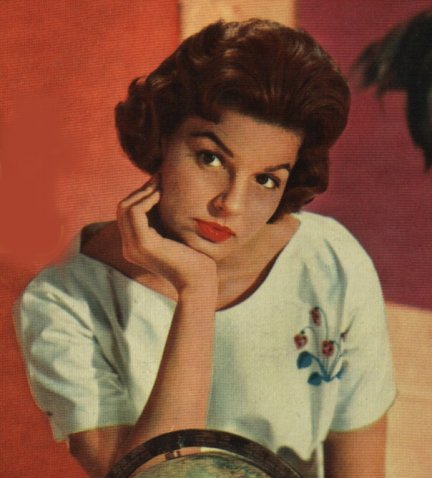 Anita Bryant was Carlton's second star. A former Miss Oklahoma and runner-up Miss
America in 1958, she signed a singing contract with Carlton shortly after Jack Scott in 1958. Her first
single, "Be Good, Be Careful, Be Mine"/"Dance On" [Carlton 473], was not successful, and it was almost
a year before she got another chance. Her second single, and first hit, was "Till There was
You" [Carlton 512], a tune from The Music Man, which reached #30 in the summer of 1959. After
a couple of mid-charting followup singles, she hit #5 with "Paper Roses" [Carlton 528] in the spring of
1960. Summer, 1960, brought another big hit, "In My Little Corner of the World" [Carlton 530], which hit
#10. She had four other chart records for Carlton, including a vocal version of "Wonderland By Night"
[Carlton 537], which made the top-20. In 1961, she moved on to Columbia, where she had a successful
single and a dozen albums by 1968. By 1970, she began recording Christian music for the Word label,
which was not surprising, since her last few Columbia albums had been Christian-oriented and she
never hid her faith. She recorded eight albums for Word in the 1970s. In addition to singing, she was in
demand as a spokesperson for various organizations, including Florida Orange Juice. She was roundly
criticized in the press for being "politically incorrect" for being honest about her beliefs about
controversial subjects, although she refused to back down under pressure. Although it is the controversy
that many younger folks remember, her early records for Carlton are still selling for collectors prices.
Anita Bryant was Carlton's second star. A former Miss Oklahoma and runner-up Miss
America in 1958, she signed a singing contract with Carlton shortly after Jack Scott in 1958. Her first
single, "Be Good, Be Careful, Be Mine"/"Dance On" [Carlton 473], was not successful, and it was almost
a year before she got another chance. Her second single, and first hit, was "Till There was
You" [Carlton 512], a tune from The Music Man, which reached #30 in the summer of 1959. After
a couple of mid-charting followup singles, she hit #5 with "Paper Roses" [Carlton 528] in the spring of
1960. Summer, 1960, brought another big hit, "In My Little Corner of the World" [Carlton 530], which hit
#10. She had four other chart records for Carlton, including a vocal version of "Wonderland By Night"
[Carlton 537], which made the top-20. In 1961, she moved on to Columbia, where she had a successful
single and a dozen albums by 1968. By 1970, she began recording Christian music for the Word label,
which was not surprising, since her last few Columbia albums had been Christian-oriented and she
never hid her faith. She recorded eight albums for Word in the 1970s. In addition to singing, she was in
demand as a spokesperson for various organizations, including Florida Orange Juice. She was roundly
criticized in the press for being "politically incorrect" for being honest about her beliefs about
controversial subjects, although she refused to back down under pressure. Although it is the controversy
that many younger folks remember, her early records for Carlton are still selling for collectors prices.
Others artists with singles during the last half of 1958 included a young Jimmy Seals (later of Seals & Crofts), Gus Backus (formerly of the Dell-Vikings), Frank Pizani (lead singer of the Highlights), perpetual label wanderer Big Al Downing, Mike Bryant, Johnny Janis, Johnny Oliver, Dick Lorenz & the Darlings, Bobo Hathaway, the Rondells (one of the many groups with this name), crooner Ed Townsend, the Royal Holidays, the Field Brothers, Morry Williams & the Kids, Sam Sideburn (hmmm, d'ya think it might be a pseudonym?), Lori & Carol Ford, the Spices, Bob Kayli, Jock Casey, the Chantones (Jack Scott's backing vocalists), Arlyne Tye, Johnny Foster, Vic Donna, Barbara Evans (who seemed to be the singer for a lot of songs on budget labels), and Rick Palmer. A string band called the Nu Tornados hit the top-30 in late 1958 with a noisy tune called "Philadelphia, U.S.A." [Carlton 492], which could have just as easily been done by their city-mates the Ferko String Band, right out of the Mummers Day Parade. The group was Eddie Dono, Phil Dale, Tom Dell, Mike Perna, and Louie Mann, all, of course, from the Philadelphia area.
Texas-born rockabilly singer Jesse Lee Turner recorded a rockin' song called "Shake, Baby, Shake" in late 1958, which was coupled with an off-the-wall novelty with "chipmunk" type sped-up voices called "The Little Space Girl" [Carlton 496]. The novelty took off after it was released in early 1959, and eventually made the national top-20, but over the years, it is "Shake, Baby, Shake" that usually draws collectors' attention. Turner's followup single, "Baby Please Don't Tease"/"Thinkin'" [Carlton 509] missed the charts completely, and Turner moved on to Fraternity, Top Rank, Imperial, and finally the GNP-Crescendo labels without much success.
Also in early 1959 was the first single for Monty Kelly & His Orchestra. Kelly was an old-time band leader, an almost 50-year-old professional who had been in the music business since the 1930s. Kelly had a number of singles and two albums for Carlton, but was also the backing orchestra leader for many of the Carlton hits over the years. His one hit single was "Summer Set" [Carlton 527], which reached #30 in the spring of 1962.
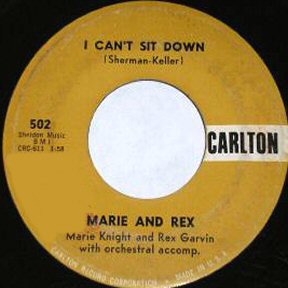 In March, 1959, Marie Knight and Rex Garvin (as "Marie & Rex") issued a
gospel-sounding tune called "I Can't Sit Down" [Carlton 502], which reached #94 on the pop charts.
Marie was no stranger to the charts, having R&B hits dating back to 1947 when she and Sister Rosetta
Tharpe were a singing team. Carlton also issued an album of gospel songs by Marie Knight, but the
single was not included on it.
In March, 1959, Marie Knight and Rex Garvin (as "Marie & Rex") issued a
gospel-sounding tune called "I Can't Sit Down" [Carlton 502], which reached #94 on the pop charts.
Marie was no stranger to the charts, having R&B hits dating back to 1947 when she and Sister Rosetta
Tharpe were a singing team. Carlton also issued an album of gospel songs by Marie Knight, but the
single was not included on it.
Other artists with singles on Carlton in 1959 included Wally Pate, Leroy & Wally, the Sons of Burgandy, Vincent Lopez (who also recorded an album), Buddy Lucas, Linda Powers, Al Allen (who was Jack Scott's guitarist), the Short Cuts, Bobby Brookes, and the Sparks.
 Gary Stites was a native of Denver, Colorado. His first single for Carlton, backed by Monty Kelly's
Orchestra, was his most successful, as "Lonely for You" [Carlton 508] reached #24 on the national
charts in the spring of 1959. He never again came close. His followup single, "A Girl Like You" [Carlton
516] only managed #80 that summer, while a third single, "Starry Eyed" [Carlton 521] — actually a demo
released commercially — only reached #77 late in the year. A remake of Lloyd Price's "Lawdy Miss
Clawdy" [Carlton 525] got some renewed attention, but stalled at #47 in early 1960. His fifth and last
single for Carlton, "Gloria Lee" [Carlton 525], didn't chart at all. Stites left Carlton and signed with the
Madison label in 1960-61, where he cut two singles that were ignored, followed by a similar experience
with a 1962 single for the Mr. Peeke label. He was last seen on Epic, where his 1966 single "Hurting"
[Epic 10064] bubbled under at #123 for a week in October, 1966.
Gary Stites was a native of Denver, Colorado. His first single for Carlton, backed by Monty Kelly's
Orchestra, was his most successful, as "Lonely for You" [Carlton 508] reached #24 on the national
charts in the spring of 1959. He never again came close. His followup single, "A Girl Like You" [Carlton
516] only managed #80 that summer, while a third single, "Starry Eyed" [Carlton 521] — actually a demo
released commercially — only reached #77 late in the year. A remake of Lloyd Price's "Lawdy Miss
Clawdy" [Carlton 525] got some renewed attention, but stalled at #47 in early 1960. His fifth and last
single for Carlton, "Gloria Lee" [Carlton 525], didn't chart at all. Stites left Carlton and signed with the
Madison label in 1960-61, where he cut two singles that were ignored, followed by a similar experience
with a 1962 single for the Mr. Peeke label. He was last seen on Epic, where his 1966 single "Hurting"
[Epic 10064] bubbled under at #123 for a week in October, 1966.
1960 was a fairly slow year for Carlton. Jack Scott's contract had been sold to Top Rank in late 1959, and Carlton agreed not to issue any more Jack Scott singles on Carlton. But the contract didn't preclude issuing albums, or issuing back catalog on another label, so Scott's singles started showing up on Guaranteed, and an album, What Am I Living For! [Carlton 12/122] was slapped together for release. The album, ostensibly issued in stereo (the stereo number was listed on the back), was probably issued in mono only. We have never seen an actual stereo copy or seen one offered for sale.
The successful singles in 1960 were by Anita Bryant, Gary Stites, Monty Kelly, in other words, the old faithful artists. The new artists had little success. These included the Paramounts, Brooks Arthur, Don Rondo (who had a hit several years earlier with "White Silver Sands"), Noreen & Donna, Lew Douglas (who also recorded an album), and Karen Chandler.
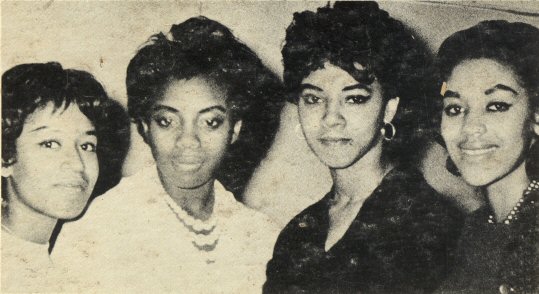 The Chantels, of course, had been hitmakers on the End and Gone labels from 1957 to 1959, but their
lead singer, Arlene Smith, had decided to embark on a solo career. Manager Richard Barrett replaced
Arlene with Annette Smith (no relation), and shopped the group to Joe Carlton. They signed with Carlton
in the summer of 1961 and hit immediately with "Look in My Eyes," [Carlton 555], which reached #14. A
followup single, "Well, I Told You" [Carlton 564], an answer song to Ray Charles' "Hit the Road Jack,"
also made the top 30 in late 1961. The third single, "Here It Comes Again" [Carlton 569], only reached
#118 when it was released in March, 1962. Carlton wanted to issue an album by the group, but only had
seven sides (fortunately, they were all recorded in stereo). To these seven (the six sides from the three
singles plus "You'll Never Know"), they added the Gus Backus single from 1958 [Carlton 471], a 1961
Chris Montez single from their subsidiary Guaranteed [Guaranteed 217], and a cut by the Imperials from
Carlton 566 in late 1961. They called this potpourri the unlikely title of The Chantels on
Tour [Carlton STLP 12/144], which obviously contained no live material at all. Also, nowhere on the
album or label does it identify which tunes are done by which artists. The only clue is the fine print on
the front cover: "...And other selections starring Chris Montez, the Imperials, Gus Backus". The added
singles were all mono, but the seven true stereo Chantels sides makes the stereo album a real
collector's item.
The Chantels, of course, had been hitmakers on the End and Gone labels from 1957 to 1959, but their
lead singer, Arlene Smith, had decided to embark on a solo career. Manager Richard Barrett replaced
Arlene with Annette Smith (no relation), and shopped the group to Joe Carlton. They signed with Carlton
in the summer of 1961 and hit immediately with "Look in My Eyes," [Carlton 555], which reached #14. A
followup single, "Well, I Told You" [Carlton 564], an answer song to Ray Charles' "Hit the Road Jack,"
also made the top 30 in late 1961. The third single, "Here It Comes Again" [Carlton 569], only reached
#118 when it was released in March, 1962. Carlton wanted to issue an album by the group, but only had
seven sides (fortunately, they were all recorded in stereo). To these seven (the six sides from the three
singles plus "You'll Never Know"), they added the Gus Backus single from 1958 [Carlton 471], a 1961
Chris Montez single from their subsidiary Guaranteed [Guaranteed 217], and a cut by the Imperials from
Carlton 566 in late 1961. They called this potpourri the unlikely title of The Chantels on
Tour [Carlton STLP 12/144], which obviously contained no live material at all. Also, nowhere on the
album or label does it identify which tunes are done by which artists. The only clue is the fine print on
the front cover: "...And other selections starring Chris Montez, the Imperials, Gus Backus". The added
singles were all mono, but the seven true stereo Chantels sides makes the stereo album a real
collector's item.
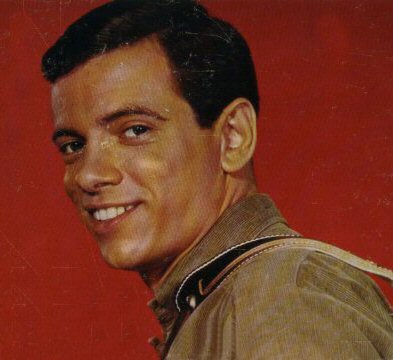 Also in 1961, Carlton moved Paul Evans from the Guaranteed subsidiary to the parent label.
Evans had had a number of hits for Guaranteed. His first, "Seven Little Girls Sitting in the Back Seat"
[Guaranteed 200], hit the national top 10 in the fall of 1959, and he followed it with two more hits,
"Midnight Special" [Guaranteed 205, #18], and "Happy-Go-Lucky Me" [Guaranteed 208, #10]. But his
fourth single, "The Brigade of Broken Hearts" [Guaranteed 210], only reached #81, and his fifth single,
"Hushabye Little Guitar" [Guaranteed 213], arguably one of his best, didn't chart at all. Guaranteed had
issued an album by Paul, but the only hit on it was "Midnight Special." In 1961, Carlton followed that with
a greatest hits package (Hear Paul Evans in Your Home Tonight) on the parent label [Carlton
12/129]. At this point, Evans was switched to the parent Carlton label for several more singles and
another album, none of which charted. He had never left songwriting, however, where he had several
more successes, including Bobby Vinton's hit "Roses Are Red," Elvis Presley's "I Gotta Know," and
musical scores for Broadway plays and movies. Evans moved to the Kapp label in 1962-63, then
recorded for Epic/Columbia in 1964-68, and many other labels in the 1970s.
Also in 1961, Carlton moved Paul Evans from the Guaranteed subsidiary to the parent label.
Evans had had a number of hits for Guaranteed. His first, "Seven Little Girls Sitting in the Back Seat"
[Guaranteed 200], hit the national top 10 in the fall of 1959, and he followed it with two more hits,
"Midnight Special" [Guaranteed 205, #18], and "Happy-Go-Lucky Me" [Guaranteed 208, #10]. But his
fourth single, "The Brigade of Broken Hearts" [Guaranteed 210], only reached #81, and his fifth single,
"Hushabye Little Guitar" [Guaranteed 213], arguably one of his best, didn't chart at all. Guaranteed had
issued an album by Paul, but the only hit on it was "Midnight Special." In 1961, Carlton followed that with
a greatest hits package (Hear Paul Evans in Your Home Tonight) on the parent label [Carlton
12/129]. At this point, Evans was switched to the parent Carlton label for several more singles and
another album, none of which charted. He had never left songwriting, however, where he had several
more successes, including Bobby Vinton's hit "Roses Are Red," Elvis Presley's "I Gotta Know," and
musical scores for Broadway plays and movies. Evans moved to the Kapp label in 1962-63, then
recorded for Epic/Columbia in 1964-68, and many other labels in the 1970s.
Also in 1961, Carlton issued several singles and an album by bandleader and future television host Merv Griffin. The first, "Banned in Boston" [Carlton 540] just missed the top-100 at #101. The second, "The Charanga" [Carlton 545] made #69 in the late spring. Other new singles artists for 1961 included Freddie Houston, Jack Melick & the Gamblers, the Strollers, the Impacts, Sid Bass, Eddie Stevens, Johnny Desmond, George Walker, Jr., Jimmie Nabbie, Kathy Dee, and the Imperials.
At the end of 1961, the Twist craze was in full force, and Carlton released a single called "The Peppermint Twist" [Carlton 565] by singer/songwriter Danny Lamego, who called himself and his band Danny Peppermint & the Jumping Jacks. (The song was a Lamego original, not the same as the Joey Dee song of the same name.) The single was inching up the charts, when on January 24, 1962, Peppermint was nearly electrocuted when he received a shock from a microphone while on stage at the Thunderbird Hotel in Las Vegas. He was rushed to the hospital and eventually recovered, but the loss of momentum didn't help his career. "Peppermint Twist" stalled at #54, and two additional singles and an album all failed to chart.
Valjean Johns, known on Carlton as just "Valjean," was an oklahoma-born pianist who had two chart records and two albums for Carlton. His first single, "The Theme From Ben Casey" [Carlton 573], made the top-30 nationally in the spring of 1962. The followup single, "Till There Was You" [Carlton 576], was backed by Ernie Freeman's Orchestra, but only reached #100. Two additional singles, pulled from the Mashing the Classicks album, failed to chart. Valjean proved to be the last chart success for Carlton. The label limped along for a couple of dozen additional singles, but by early 1964, was finished. Other new singles artists for 1962 and later included the Persuaders, Carol Hughes, Tony Richardo, the Pipes (a college glee club who also had an album), Billy Frazier, Kenny Williams, Maureen Arthur, Rick Martell, Jerry Palmer, Cindy Rella & Her Stepsisters (??!), Gayle Harris, Sonny Campbell, the Con-Dons, the Centuries, Orval Prophet, Jesse & James, Jessie Williams, Gordon & Sue & the Algonquins, the Defenders, Jo & Joyce, the Alcoves Friedel Berklipp, Chip and the Quarternotes, and Rick Skylar (who had the last single, #605).
All in all, Carlton was a very interesting label. Their recordings and vinyl pressings were impeccable and their roster of artists interesting. Now if we can only find those master tapes...
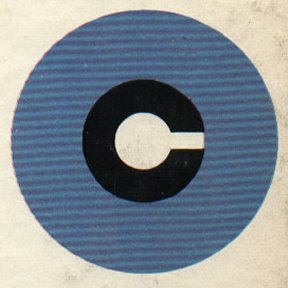 Carlton Album Discography
Carlton Album Discography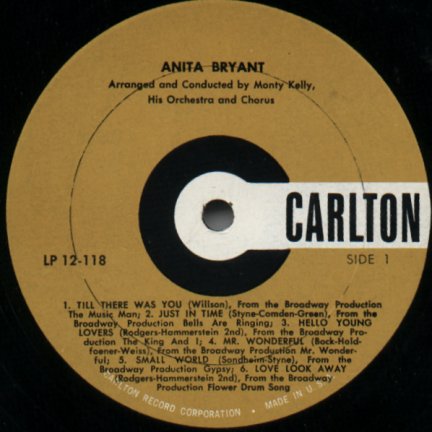
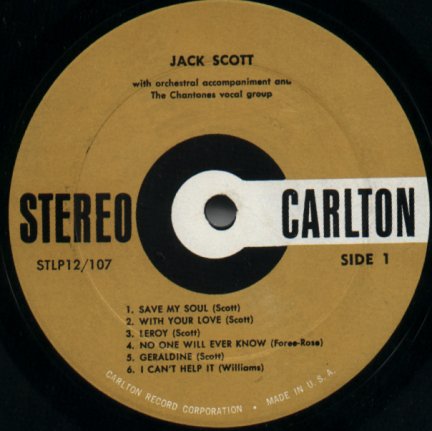
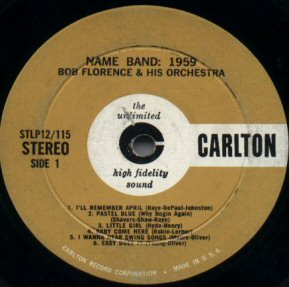
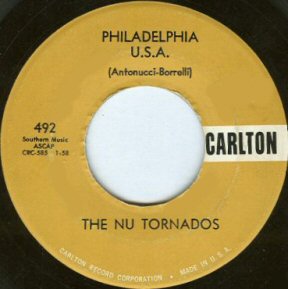
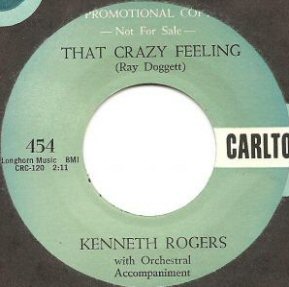



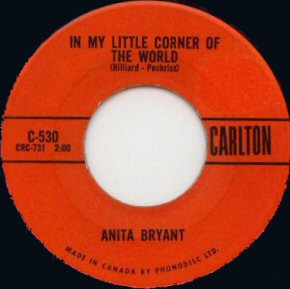

 On to the Carlton Album Discography, Part 3 EPs, Stereo
Singles, and Related LPs/CDs
On to the Carlton Album Discography, Part 3 EPs, Stereo
Singles, and Related LPs/CDs  Back to the Discography Main Page
Back to the Discography Main Page